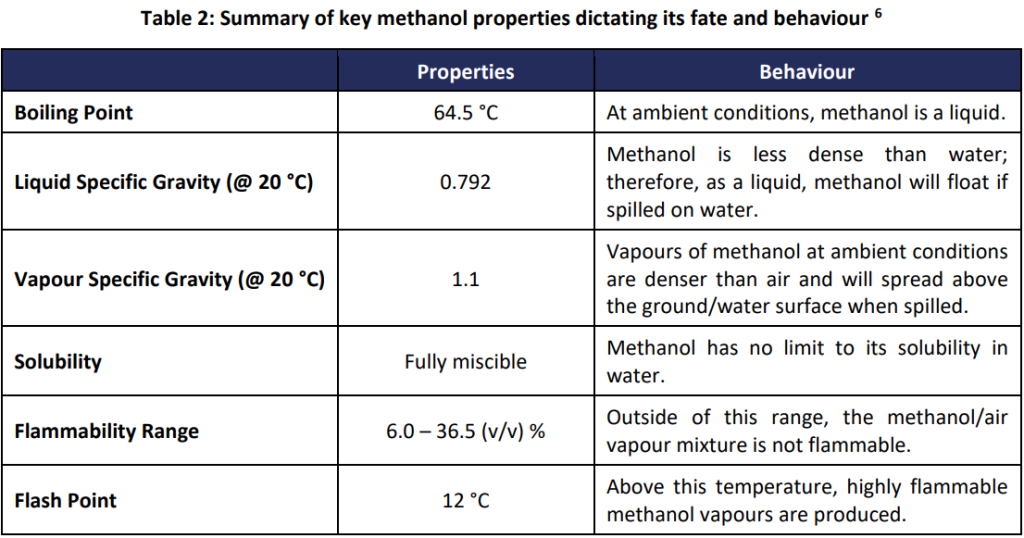ITOPF: Consequences of an methanol spill in the marine environment
ITOPF has published a report focusing on methanol as an alternative marine fuel, highlighting the unique impacts associated with the fuel’s properties.
According to the report “Fate, Behaviour, Potential Damage & Liabilities Arising from a Spill of Methanol in the Marine Environment”, the Standard European Behaviour Classification (SEBC) categorises methanol as a dissolver that evaporates (DE). During an incident, methanol’s hazards will be the drivers for the first actions and emergency response, followed by specific actions linked to its behaviour classification.
When spilled into the marine environment, methanol would float, rapidly spreading on the sea surface and dissolving into the water column while simultaneously undergoing evaporation.
RelatedNews

Vapours emanating from the sea surface will not immediately rise due to their density and will spread over the ground or water surface when spilled. The vapour cloud has a larger flammability footprint than lighter and more volatile LNG and hydrogen that readily rise and disperse. The extent of the vapour cloud spreading will mainly depend on the rate of the spill and the metocean conditions. Even in moderate wind speeds, an ignition of the vapour cloud and subsequent fire may still be able to propagate back to the leak source until all methanol is consumed below the LFL or is extinguished.
The rate at which methanol dissipates depends on the amount of mixing in the aquatic environment, influenced by tidal currents combined with wind-induced wave action. Although many environmental factors will influence the fate of methanol, a methanol release in open water is likely to disperse to non-toxic levels (<1%) at a much faster rate than petroleum hydrocarbons, with some studies giving methanol a half-life between one and seven days. Studies have stated that this short half-life is predominantly due to biodegradation. As methanol is naturally occurring in the environment, microorganisms exist that can oxidise methanol into formaldehyde, and then subsequently formic acid until carbon dioxide and water remain. Volatilisation is also stated to play a major role in the decomposition of methanol in the marine environment.
Hazards of methanol when spilled in the marine environment
Methanol’s hazards can lead to direct impacts to health and safety, mainly through its flammability, explosivity, and toxicity.
Flammability
Methanol and its vapours are highly flammable, with a flammability range of 6 – 36.5 (v/v) %, which can be detected with specialised equipment. Outside of this range, the methanol/air mixture is not flammable. This is greater than conventional fuels such as diesel, which has a much smaller flammability range of 0.6 – 5.5 (v/v) %. In addition, the flash point of methanol is 12 °C, meaning that 12 °C is the lowest temperature at which vapours emanate from methanol in sufficient quantities to form an ignitable vapour/air mixture. It should be noted that methanol flames are almost invisible to the eye during daylight.
In an unconfined space, a release of methanol from a tank or pipeline will flow from the puncture hole and spread over a large area, forming a thin layer that will undergo evaporation and possible dissolution if in contact with water. Only a small area near the immediate leak would likely reach the concentration above the 6% lower flammability limit (LFL) that would allow methanol to ignite. In a confined space, where flammable vapours cannot spread and dissipate, a small leak could lead to a flammable vapour/air mixture. Inside a fuel storage tank, the percentage of methanol is almost pure, and the conditions are not within its flammability range. However, following a leak/rupture, a dense vapour cloud will form, and once it has mixed with air, when its concentration reaches between the LFL and the upper flammability limit (UFL), the mixture can sustain a flame if ignited. If ignition occurs immediately, a flash fire is likely to result and continue until all the fuel is consumed.
Explosivity
As methanol has a wide explosive range (6 – 36.5 (v/v) %), even small leaks have the potential to burn or explode. If leaked methanol concentrates in a confined space, there is a significant risk of combustion and explosion, meaning that a spark or hot surface may cause ignition. Ignition of a flammable vapour/air mixture may result in a possible deflagration to detonation transition (DDT) and a subsequent large explosion. These events are unpredictable and not well understood at this time.
Methanol released in sufficient quantities can create a harmful overpressure, which may result in direct and indirect hazards from building damage or flying debris. Overpressures can occur as a result of the ignition of a cloud of released flammable gas. In particular conditions, typically a fire, methanol could potentially undergo a boiling liquid expanding vapour explosion (BLEVE), which is an explosion caused by the rupture of a tank containing a liquid that has reached a temperature above its boiling point, in the case of methanol, 64.5 °C. This could occur if the temperature of the tank were to rise and gas release systems were to fail.
Asphyxiant
Like any gas in a confined environment, high concentrations of methanol vapours displace oxygen in the air, decreasing oxygen availability and leading to asphyxiation for those present in these confined environments. Methanol vapours will not dissipate in enclosed, unventilated areas, as vapours are denser than air.
Toxicity
The likely routes of acute methanol exposure are via inhalation or dermal contact. In the event of mild exposure to methanol and its vapours, the symptoms are similar to ethanol intoxication, with headaches, dizziness, nausea, and blurry vision being commonplace. If the exposure is significant, there may be a latent period for 10 – 48 hours, until more serious symptoms such as violent abdominal pain, temporary or permanent blindness, coma, and possibly death due to respiratory failure occur. The latent period is due to methanol being metabolised into formaldehyde and formic acid, which are the main toxic agents responsible for the above effects. It should be noted that for toxic effects to take place via inhalation and dermal contact, prolonged periods of high methanol concentrations (approximately 3,000 ppm for 8 hours or 20,000 ppm for 1 hour) would be required.
Ecotoxicity
As methanol concentrations rapidly decrease in the water column due to spreading, biodegradation, and volatilisation, and has a low aquatic toxicity and bioaccumulation potential, direct environmental damage is expected to be negligible. Significant biodegradation due to microbial activity may lead to hypoxic or anoxic conditions in sheltered waters; however, this is expected to be short-lived due to methanol’s non-persistence in the marine environment.
Claims arising from incidents involving methanol
Methanol’s short residence time in the marine environment and high volatility means that claims arising from incidents involving this alternative fuel would greatly contrast those associated with conventional persistent hydrocarbon oil spills. Claims from clean-up and preventive measures are expected to arise from different approaches, such as source control, fire-fighting measures, monitoring via expert modelling or sensors mounted on UAVs/ROVs, and possible bunker fuel removal.
Traditional clean-up measures will not be possible, and therefore, claims from a protracted spill clean-up operation will not arise. However, personal injury and loss of life claims may be significant. Risks from fire, explosions, toxic and asphyxiating vapours could lead to death or life-altering injuries to crew, passengers, nearby operators, and members of the public.
Claims arising from environmental damage
Claims arising from environmental damage are likely to be geographically confined in comparison to damage from oil spills. Post-spill studies may be undertaken, in certain circumstances, to establish the severity and extent of damage. Restoration measures are likely to be minimal and, if any, confined to a small area. Rather than property damage claims involving cleaning and cosmetic repair of oiled property, methanol claims are more likely to result from fire or explosion. As a result, structural repair or replacement may be required, which would likely be more costly and potentially time-consuming.
Economic loss claims
Economic loss claims resulting from a fire or explosion could include port closure/disruption and associated demurrage costs, losses from damaged or destroyed property, local aquaculture losses from mortality of stock, and local losses resulting from fishing bans. Impacts to commercial water intakes and tourism may also occur.
Content Original Link:
" target="_blank"> English
English Chinese (Simplified)
Chinese (Simplified) Finnish
Finnish French
French German
German Greek
Greek Italian
Italian Norwegian
Norwegian Spanish
Spanish Swedish
Swedish



































































